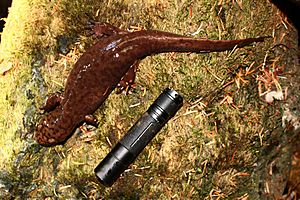Coastal giant salamander facts for kids
Quick facts for kids Coastal giant salamander |
|
|---|---|
 |
|
| Conservation status | |
| Scientific classification | |
| Synonyms | |
|
Amblystoma tenebrosum Baird and Girard, 1852 |
The coastal giant salamander (Dicamptodon tenebrosus) is a large type of salamander. It belongs to a group called Pacific giant salamanders. These amazing creatures are found only in the Pacific Northwest part of North America.
There are three other kinds of giant salamanders that are closely related to the coastal giant salamander. These are the California giant salamander, Cope's giant salamander, and Idaho giant salamander.
Contents
What Does It Look Like?
The coastal giant salamander is the biggest salamander that lives on land in North America. It can grow up to 34 centimeters (about 13 inches) long! That's almost as long as a ruler.
These salamanders have strong legs. Their front feet have four toes, and their back feet have five toes. Their tail is about 40 percent of their total length and is flattened from side to side.
Their skin has a cool marbled pattern. It has dark spots and blotches on a lighter brown or brassy background. They have a wide head that looks a bit like a shovel. They also have a special fold of skin on their throat called a gular fold. Their eyes are medium-sized with a shiny, brassy color and a big black center.
Did you know that coastal giant salamanders are one of the few salamanders that can make sounds? They can actually vocalize!
Life Stages of the Salamander
Female coastal giant salamanders lay their eggs in mountain streams. They choose places where the water flows slowly, often under rocks or in cracks. The eggs usually hatch in the spring.
Coastal giant salamanders go through two main stages in their lives:
- Larval stage: This is like their "baby" stage. They live in water and have feathery gills on the outside of their bodies. They also have a long tail with a fin, much like a tadpole.
- Adult stage: As they grow, they change into their adult form. They lose their external gills and tail fin. Instead, they grow strong legs and develop lungs to breathe air.
What Are Neotenes?
Sometimes, some coastal giant salamander larvae don't change into the adult form. They keep their external gills but still grow big and can have babies. This special process is called neoteny. It's quite common for these salamanders in British Columbia to stay in their larval form. These adult-sized neotenes usually have a plain brown color on their heads, sides, and backs.
How Do They Behave?
Where Do They Spend Their Time?
Adult coastal giant salamanders that live on land spend most of their time hidden. They live underground in burrows. They usually only come out at night when it's rainy or humid. This is when they look for food and find mates.
What Do They Eat?
Coastal giant salamanders are not picky eaters! They will eat almost anything they can fit into their mouths. This includes:
- Slugs
- Insects
- Worms
- Other small creatures without backbones
- Small animals with backbones, like tiny rodents, snakes, and even other giant salamanders!
When they are in their larval stage, they eat smaller things. They munch on tiny water insects, small fish, and snails. Both young and adult coastal salamanders have sometimes been seen eating other salamanders of their own kind.
How Do They Protect Themselves?
When a coastal giant salamander feels threatened, it has a few ways to defend itself. It will arch its back and quickly lash its tail forward.
They also have a special defense: their skin can release toxins. If another animal tries to eat them, these toxins can make them feel sick. Plus, adult coastal giant salamanders can give a painful bite!
Where Do They Live?
The coastal giant salamander is found only in the Pacific Northwest. You can find them in northern California, Oregon, Washington, and southern British Columbia.
What Kind of Home Do They Like?
When they are young and live in water, they prefer clear, cool, or cold streams. These streams need to have plenty of oxygen. Sometimes, you can also find them in mountain lakes and ponds.
Adult salamanders that live on land like humid forests. They hide under rocks and logs, near mountain streams, or on the rocky edges of mountain lakes.
How Are They Protected?
In British Columbia, Pacific giant salamanders are protected by law. This means it is against the law to kill or collect them. This helps make sure these amazing creatures can continue to thrive in their natural homes.
Images for kids




